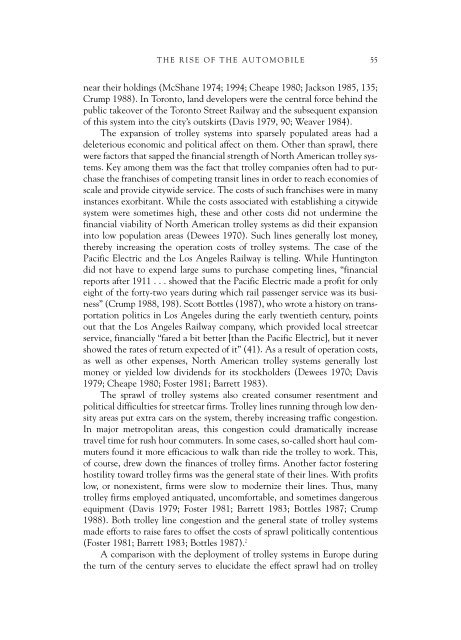GEORGE A. GONZALEZ - fieldi
GEORGE A. GONZALEZ - fieldi
GEORGE A. GONZALEZ - fieldi
Create successful ePaper yourself
Turn your PDF publications into a flip-book with our unique Google optimized e-Paper software.
THE RISE OF THE AUTOMOBILE 55near their holdings (McShane 1974; 1994; Cheape 1980; Jackson 1985, 135;Crump 1988). In Toronto, land developers were the central force behind thepublic takeover of the Toronto Street Railway and the subsequent expansionof this system into the city’s outskirts (Davis 1979, 90; Weaver 1984).The expansion of trolley systems into sparsely populated areas had adeleterious economic and political affect on them. Other than sprawl, therewere factors that sapped the financial strength of North American trolley systems.Key among them was the fact that trolley companies often had to purchasethe franchises of competing transit lines in order to reach economies ofscale and provide citywide service. The costs of such franchises were in manyinstances exorbitant. While the costs associated with establishing a citywidesystem were sometimes high, these and other costs did not undermine thefinancial viability of North American trolley systems as did their expansioninto low population areas (Dewees 1970). Such lines generally lost money,thereby increasing the operation costs of trolley systems. The case of thePacific Electric and the Los Angeles Railway is telling. While Huntingtondid not have to expend large sums to purchase competing lines, “financialreports after 1911 ... showed that the Pacific Electric made a profit for onlyeight of the forty-two years during which rail passenger service was its business”(Crump 1988, 198). Scott Bottles (1987), who wrote a history on transportationpolitics in Los Angeles during the early twentieth century, pointsout that the Los Angeles Railway company, which provided local streetcarservice, financially “fared a bit better [than the Pacific Electric], but it nevershowed the rates of return expected of it” (41). As a result of operation costs,as well as other expenses, North American trolley systems generally lostmoney or yielded low dividends for its stockholders (Dewees 1970; Davis1979; Cheape 1980; Foster 1981; Barrett 1983).The sprawl of trolley systems also created consumer resentment andpolitical difficulties for streetcar firms. Trolley lines running through low densityareas put extra cars on the system, thereby increasing traffic congestion.In major metropolitan areas, this congestion could dramatically increasetravel time for rush hour commuters. In some cases, so-called short haul commutersfound it more efficacious to walk than ride the trolley to work. This,of course, drew down the finances of trolley firms. Another factor fosteringhostility toward trolley firms was the general state of their lines. With profitslow, or nonexistent, firms were slow to modernize their lines. Thus, manytrolley firms employed antiquated, uncomfortable, and sometimes dangerousequipment (Davis 1979; Foster 1981; Barrett 1983; Bottles 1987; Crump1988). Both trolley line congestion and the general state of trolley systemsmade efforts to raise fares to offset the costs of sprawl politically contentious(Foster 1981; Barrett 1983; Bottles 1987). 2A comparison with the deployment of trolley systems in Europe duringthe turn of the century serves to elucidate the effect sprawl had on trolley









